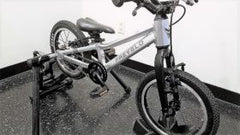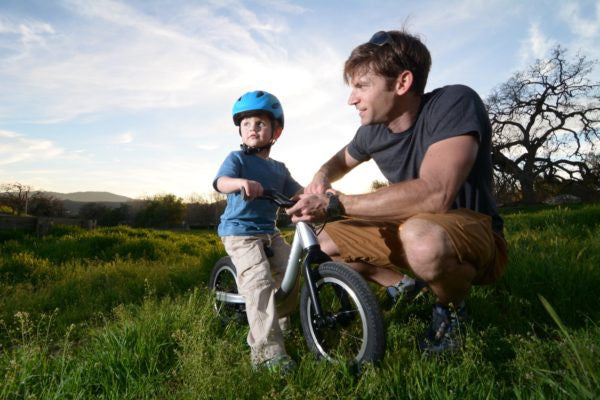If you’ve taken a gander at the Prevelo product line you might notice something missing: training wheels. A few people have asked why no Prevelo bikes have training wheels. Here’s why, in the form of a numbered list, because I heard people on the internet like numbered lists.
In order to ride a bike a new rider needs to learn three basic skills: (1) balance, (2) pedaling and (3) steering. I also consider braking a basic skill. But many children learn to brake after they learn to ride. It’s also not uncommon for beginning riders to start by using their shoes as brakes. (PSA: Good biking shoes for kids should have plenty of rubber on them, especially at the toe. If you have an enthusiastic young bike rider, consider buying a spare pair.)
1. Training Wheels Don’t Teach Balance
Balance is for most young riders the most challenging of the four basic skills. Training wheels don’t teach balance. Kids learn to balance on two wheels by being on two wheels.
2. Training Wheels are Inferior for Teaching Steering
Ask some people how a bike balances and you’ll get mix of blank stares and perhaps some vague mumblings about the gyroscopic effect of the wheels. In fact, the rider’s steering is what keeps the bike on two wheels and upright. Balance and steering on a bicycle are integral. Since bicycles with training wheels don’t balance like a two-wheeled bike, they also don’t steer like a two-wheeled bike. Bicycles with training wheels have a limited ability to help young riders learn to steer a bicycle.
3. Training Wheels Teach Pedaling, But Pedaling is Easy to Learn
 If you’ve watched a child on a two wheeled pedal bike for the first time, you realize its an intimidating and frustrating moment. That moment requires the rider to simultaneously balance, steer and pedal. One key to making the moment easier is to allow the young rider to prepare for that moment by learning some of those skills in advance. Training wheels are essentially a way to teach pedaling first, and then adding the balance and steering elements by removing the training wheels. A popular alternative is to start young riders on a balance bike, a bike with no pedals (like our own Alpha Zero). A balance bike teaches balance and steering, but not pedaling. Both balance bikes and bikes with training wheels generally acclimate children to the general feeling of being on a bike. So the primary difference is the order in which skills are taught. Bikes with training wheels teach pedaling and defer balance and steering to the moment the training wheels are removed. Balance bikes teach balance and steering and defer pedaling to the moment pedaling is added to the equation.
If you’ve watched a child on a two wheeled pedal bike for the first time, you realize its an intimidating and frustrating moment. That moment requires the rider to simultaneously balance, steer and pedal. One key to making the moment easier is to allow the young rider to prepare for that moment by learning some of those skills in advance. Training wheels are essentially a way to teach pedaling first, and then adding the balance and steering elements by removing the training wheels. A popular alternative is to start young riders on a balance bike, a bike with no pedals (like our own Alpha Zero). A balance bike teaches balance and steering, but not pedaling. Both balance bikes and bikes with training wheels generally acclimate children to the general feeling of being on a bike. So the primary difference is the order in which skills are taught. Bikes with training wheels teach pedaling and defer balance and steering to the moment the training wheels are removed. Balance bikes teach balance and steering and defer pedaling to the moment pedaling is added to the equation.
Training wheels vs. Balance bike
Which is the better training aid? The answer to this question lies in relative difficulty of these skills. Between balance, steering and pedaling, which skills are most riders going to find more difficult or intimidating to learn? From my experience, the answer is clearly that balance and steering are more difficult and intimidating for young riders than pedaling. If you want to test my hypothesis, here’s an experiment to try. Put a child on a balance bike and let them focus on steering and balancing. Then put a kids pedal bike on a trainer, taking balance and steering out of the equation, and let them pedal.
 It takes most young riders hours of riding a balance bike to get the hang of steering and balance. But most kids can learn to pedal a stationary bike in less time than it takes you to setup the bike on the trainer. So, if you are going to equip your child with a training aid to prepare them for riding, a balance bike is the way to go.
It takes most young riders hours of riding a balance bike to get the hang of steering and balance. But most kids can learn to pedal a stationary bike in less time than it takes you to setup the bike on the trainer. So, if you are going to equip your child with a training aid to prepare them for riding, a balance bike is the way to go.
Pro Tip: If your child is older and can straddle a pedal bike with both feet firmly on the ground, you can get them a pedal bike and remove the pedals from the bike so they can learn balance. When they get the hang of balance, slap the pedals back on.
4. Training Wheels Have Unnecessary Safety Issues
I struggled with this section. Parents have plenty to read about perils to their child’s safety without me contributing to the noise. Kids fall when they play. Kids fall when they ride bikes. And kids are astoundingly well equipped to weather these falls. But training wheels add an unnecessarily scary element. The problem with training wheels are two fold. First, because a child cannot lean into a turn on training wheels, they are ill equipped to counter centrifugal force, which will pull them towards the outside of the turn and shift their mass to the outside training wheel. This can result in the rider tipping towards the outside of the turn (known as a high side crash). Second, because the training wheels are not connected to brakes, if the rear wheel of the bike is ever lifted off of the ground by the training wheels (which occurs during a high side event and also when riding over certain uneven surfaces), then the rider has no braking ability. The later event also tends to occur when the rider is high off the ground and cannot get their feet on the ground.
Unnecessary spooky moments
Both of these events are spooky moments for a rider. Both have the potential to result in the rider having a sudden and intimate rendezvous with asphalt. But kids are well equipped to handle brushes with asphalt. The problem with training wheel related incidents is they often involve tipping onto a training wheel, leaving the rider with little control of the bike (since the training wheels cannot be driven or braked). Prior to kissing the ground, the rider is forced to live through a moment where they feel out of control and along for the ride, waiting for impact. This makes training wheels incidents scary. While riding a bike requires children to overcome a healthy amount of intimidation, training wheels add what I believe are unnecessary scary moments. Learning to ride a bike is intimidating enough without these unnecessary scary moments.
So, if you have a future rider under your fold, forget the training wheels. Put them on a pedal-less bike and let them learn balance and steering. Then help them transition to a pedal bike. Enjoy this moment. You won’t be able to keep up with them for long!
